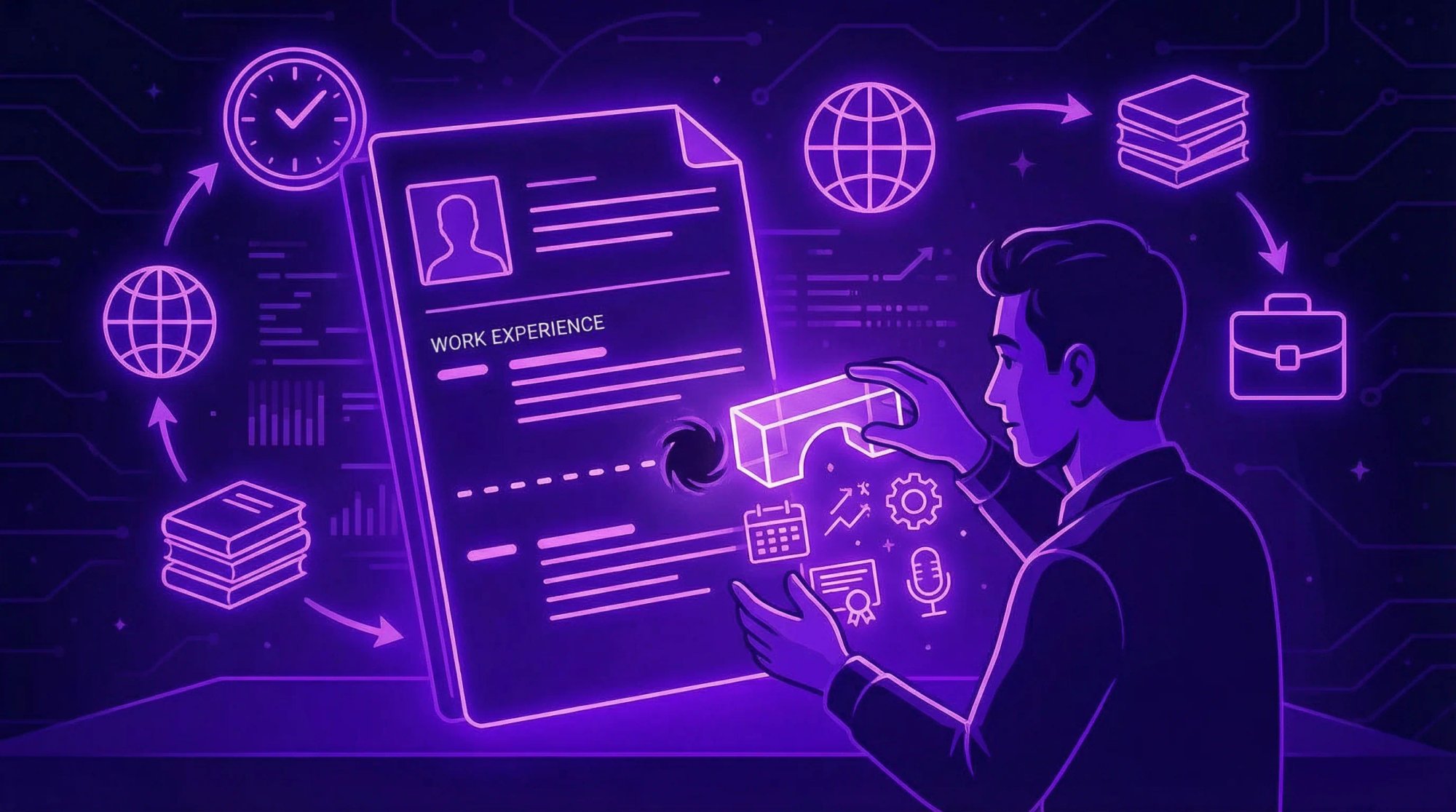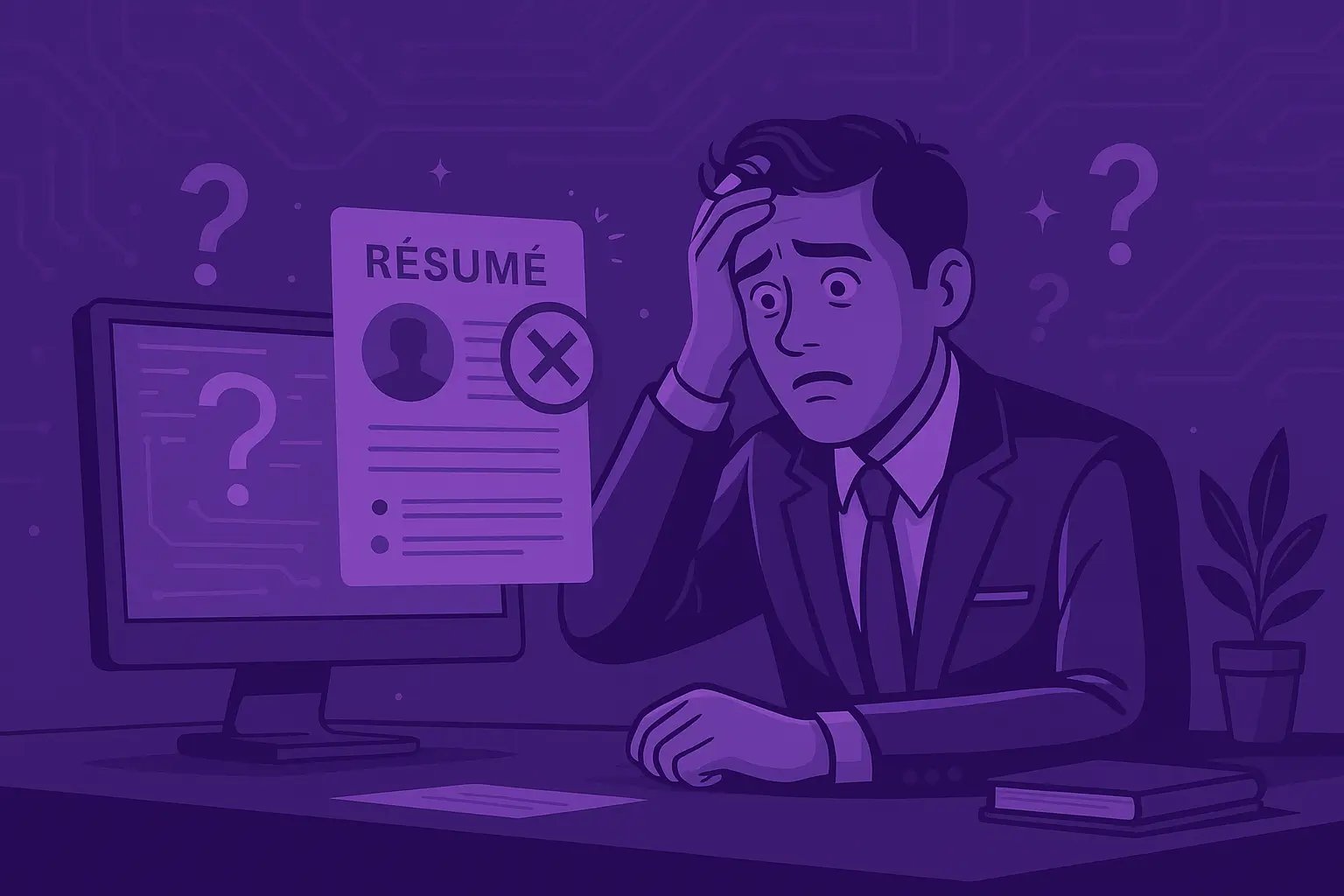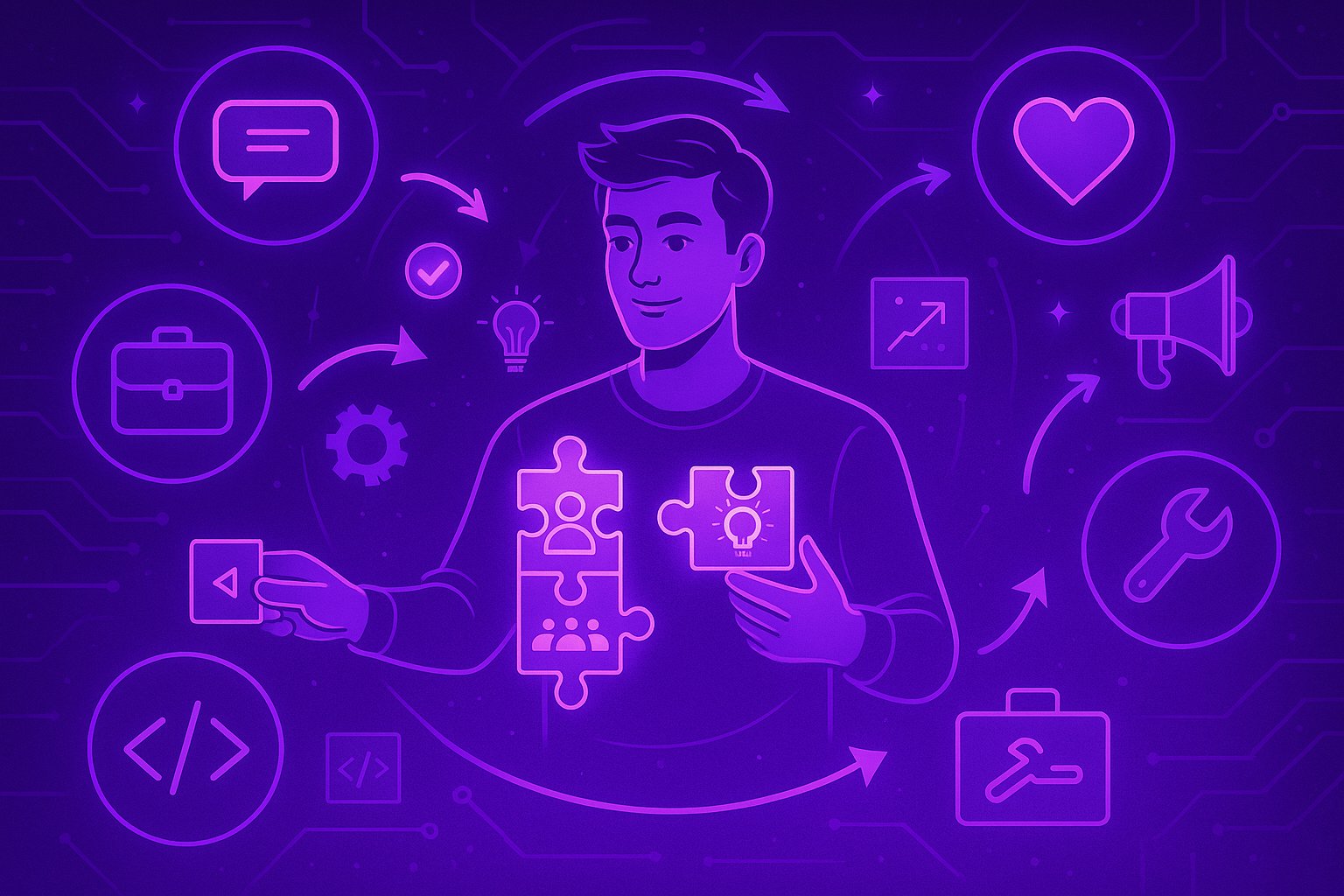Crafting Your Perfect Interview Follow Up Message
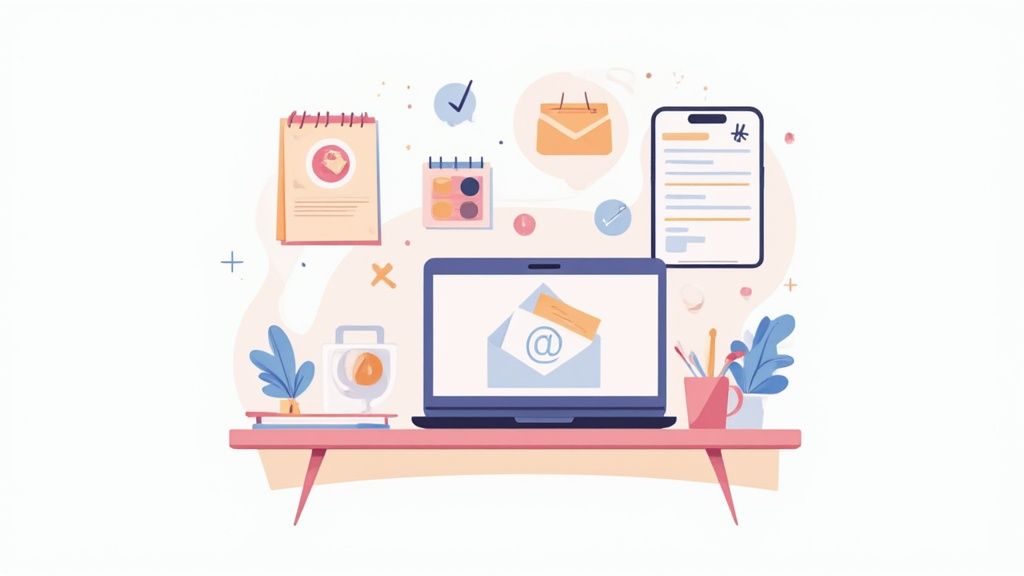
Think the interview is over once you’ve logged off the video call or walked out the door? Not even close. Sending a follow-up message isn't just about being polite—it's one of the most underrated, strategic moves you can make in your job search.
This isn't just a thank-you note. It's your last chance to make a great impression, stand out from a sea of other candidates, and keep the conversation going.
Why Your Follow-Up Still Matters in Modern Hiring
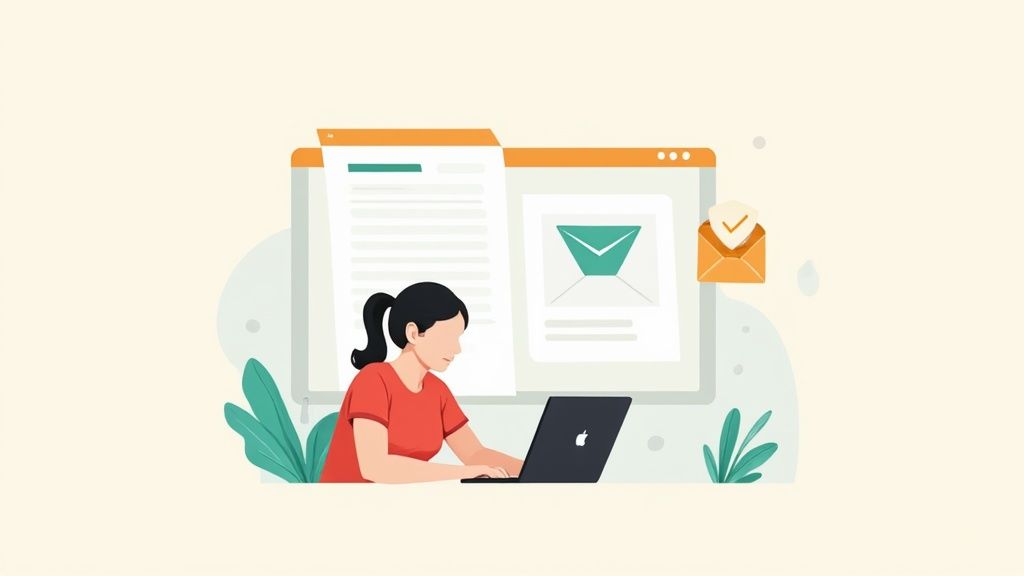
In a world full of automated application systems and back-to-back virtual meetings, a genuine human touch goes a long way. Your follow-up message is exactly that—a rare chance to show your personality and professionalism outside the formal interview structure.
This is more than just good manners. It’s a smart, calculated move. A great follow-up proves you’re engaged, detail-oriented, and truly excited about the role. While other candidates might just blend into the background, a thoughtful message makes you memorable.
The Strategic Advantage of a Thoughtful Message
A well-crafted follow-up can do some serious heavy lifting for you and can genuinely sway a hiring manager's decision. It's your opportunity to:
- Show you’re still all in. Reiterate your enthusiasm for the job. It tells the interviewer your excitement wasn’t just an act for the camera.
- Connect the dots for them. Subtly remind them of a key skill you have that directly solves a problem they mentioned. You’re reinforcing why you’re the perfect fit.
- Prove your professionalism. Prompt, polite communication is a non-negotiable soft skill. Your follow-up is a real-time demonstration of that.
This is how you separate yourself from a pack of otherwise equally qualified people. You’re turning a simple courtesy into a powerful statement about your personal brand.
Let’s be real: hiring managers are swamped. A fantastic follow-up doesn't just remind them who you are—it makes their job easier by neatly summarizing your value and passion in one place.
Adapting to the Digital Hiring Process
With hiring moving increasingly online, the follow-up has become more critical than ever. We've all been in those slightly awkward virtual interviews where it's tough to build a real connection. In fact, 81% of recruiters expect virtual interviews to stick around long-term.
A personalized message helps cut through that digital distance. It conveys a genuine interest that sometimes gets lost over a video call. You can learn more about navigating these changes by exploring modern job search techniques.
Taking a few minutes to send a message shows you get the nuances of professional communication—a vital skill for any job today. You’re not just "checking a box." You're making one final, compelling argument for why you’re the right person for the team.
Mastering the Follow-Up Timeline
When it comes to the job search, timing can make or break your chances. Send that follow-up message too quickly, and you might come across as desperate. But wait too long, and your fantastic interview could become a distant memory in a hiring manager's busy week. Hitting that sweet spot shows you're professional, respectful, and genuinely interested.
The "24-hour rule" is the gold standard here. Always, always aim to send your initial thank-you note within one business day of the interview. This simple act keeps the great conversation you had fresh in their minds and puts you at the top of the pile.
This visual guide lays out the perfect cadence for your follow-up strategy.
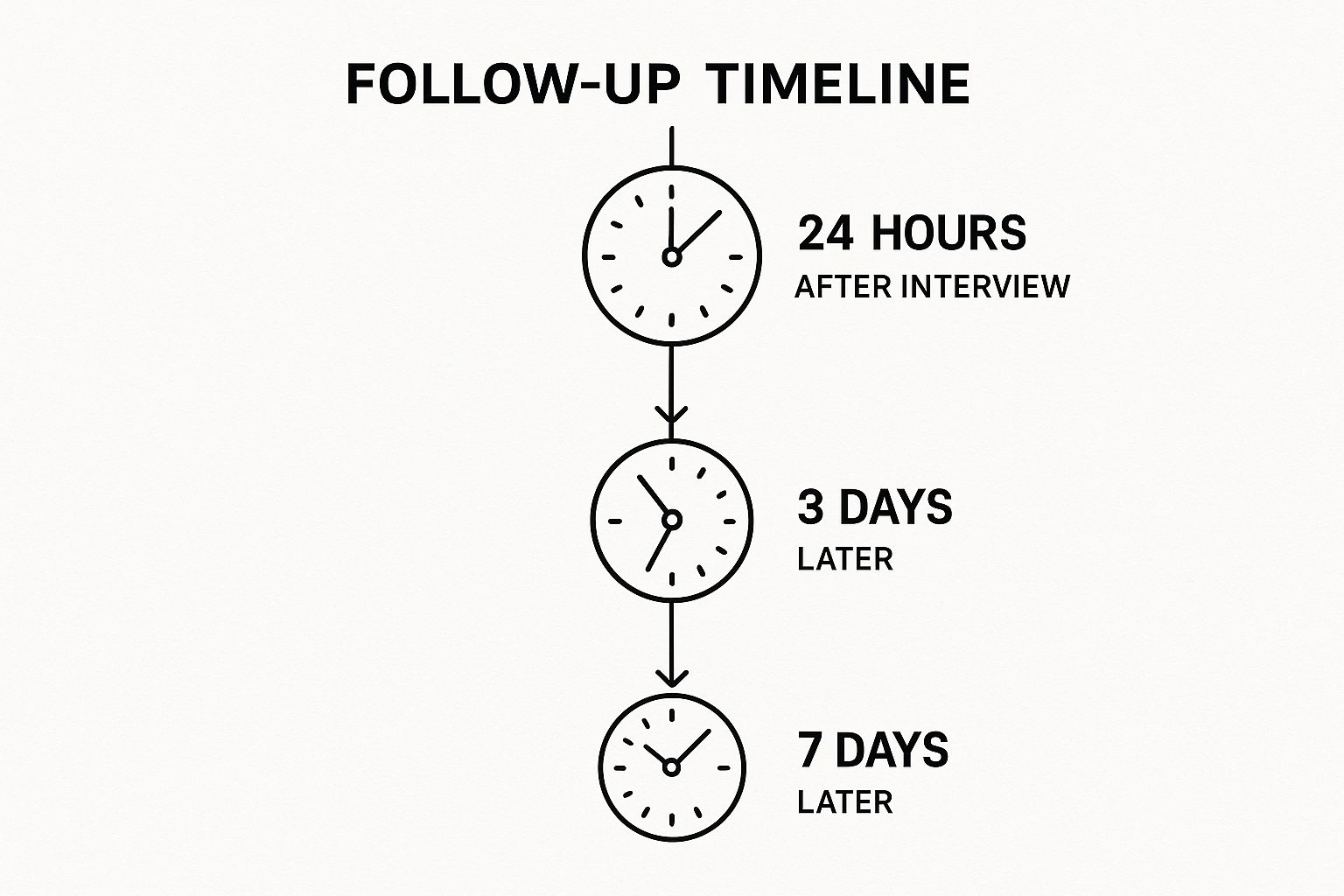
As you can see, the key is to space out your communication. You want to show persistence, not become a pest.
To help you visualize this, here’s a simple breakdown of the ideal timeline.
Interview Follow Up Message Timeline
This structure ensures each message has a clear purpose and arrives at just the right moment.
Your First Move: The 24-Hour Thank You
This first email is non-negotiable. Seriously. It's your immediate chance to say thanks for their time, remind them of your excitement for the role, and smartly connect one of your skills to a specific point you discussed. A prompt message confirms your interest and establishes a professional, thoughtful tone from the get-go.
Think of it as a firm, digital handshake. It’s a small gesture, but it’s one that over 90% of interviewers actually appreciate. It’s a tiny action that leaves a huge positive impression.
What to Do When You Hear Crickets
Okay, so you sent the perfect thank-you, and now you're just waiting. If the hiring manager gave you a timeline—for example, "We'll be making a decision by the end of next week"—you absolutely have to respect it. Don't even think about pinging them before that date has passed.
If they didn't give you a specific date, a good rule of thumb is to wait about one full business week before sending a polite check-in. This shows you're still engaged and eager but also patient and respectful of their process.
A polite check-in isn't about asking, "So, did I get the job?" It's a professional nudge to ask about the status of the hiring process and gently remind them of your continued interest.
For instance, your note could be as simple as: "I hope you're having a great week. I'm just checking in on the timeline for the [Job Title] position and wanted to reiterate my strong interest. I'm really excited about the possibility of joining your team."
This approach keeps the dialogue open without putting anyone on the spot. This kind of thoughtful communication is just as crucial as the message you send right after applying. If you need some ideas, you can find great tips for crafting a compelling follow-up email for a resume that you can easily adapt for this situation.
Tweaking Your Timing for Different Interview Types
The exact timing might need a little adjustment depending on the interview format. You want your follow-up to match the tone and stage of the hiring process.
- Phone Screen: A quick, to-the-point thank-you within 24 hours is all you need. The follow-up cadence can be a bit more relaxed here.
- Multi-Person Panel: This requires more effort. Send a personalized thank-you note to each interviewer within 24 hours. After a week, a single follow-up to your main point of contact is enough.
- Final Round Interview: The stakes are high. Your 24-hour thank-you should be detailed and exceptionally thoughtful. The check-in you send a week later needs to be polished and professional, reinforcing your value one last time.
Once you get this timeline down, your follow-up messages become a powerful part of your strategy, ensuring your communication always comes across as proactive, not pushy.
The Anatomy of a Memorable Follow-Up Email
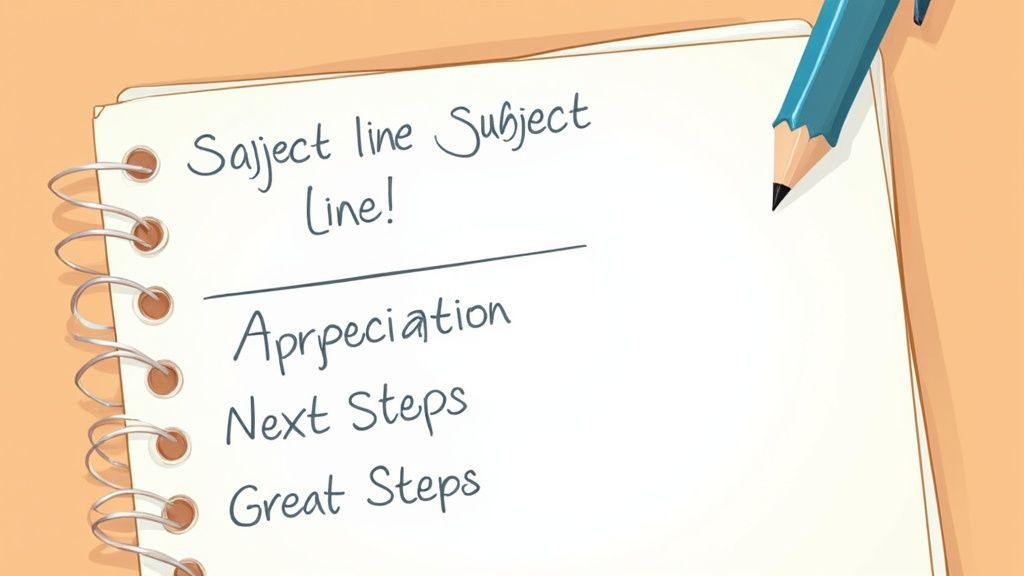
It’s time to ditch the generic, copy-paste templates. Let's build a follow-up email that a hiring manager will actually read, remember, and maybe even forward to the team.
Think of your email not as a single block of text, but as a series of strategic moves. Each part has a specific job. When you put them all together, you get a powerful message that reinforces why you're the right person for the job.
The goal here isn't just to say "thank you." It's to prove you were listening, to show off your professionalism, and to gently remind them that you are the solution to their problems. Every single line counts.
Crafting a Subject Line That Actually Gets Opened
Your subject line is the gatekeeper to the inbox. If it’s vague, weird, or unprofessional, your carefully written message might get buried or deleted without a second thought.
Keep it simple, clear, and professional. The hiring manager should know exactly who you are and what the email is about in a single glance. A winning formula usually mixes a brief "thank you" with the job title you interviewed for.
Here are a few no-nonsense examples:
Thank you - Marketing Manager InterviewFollowing up on the Project Coordinator roleJohn Smith - Follow up regarding Senior Analyst position
This approach is direct and instantly recognizable. It helps the hiring manager categorize your message in their sea of emails.
The Opening: Your Personalized Greeting
Always start strong by addressing the interviewer by their name. A generic "To Whom It May Concern" is a dead giveaway that you're just going through the motions. Use whatever name they introduced themselves with—if they said, "call me Jen," use Jen.
Right after that, express your thanks for their time. It's more than a formality; it shows you respect their packed schedule. Keep it genuine and to the point.
Pro Tip: If you met with several people, send each one a separate, slightly tweaked email. Mentioning a specific point that only you and that person talked about is an expert-level move. It proves you were actively engaged with everyone, not just the head honcho.
The Body: Connecting Your Value to Their Problems
This is where you make your money. The body of your email has two critical jobs: reiterate your excitement for the role and connect your skills to a specific challenge they're facing. This is your chance to add a little more value to the conversation you started.
Think back to the interview. What was the biggest headache or project they mentioned? Maybe they’re losing users, trying to break into a new market, or just need to fix a clunky internal process. Grab onto that pain point.
For instance, you could write something like: "I really enjoyed our conversation about streamlining the customer onboarding process. In my last role at XYZ Corp, I actually led a project that cut new-user churn by 15% in the first quarter by implementing a similar strategy."
See what that does? It transforms your thank-you note into a mini-case study. You're not just telling them you have the skills; you're proving it with a real, relevant number. If you need more ideas on hitting the right professional-yet-personable tone, checking out some other professional email examples can be a huge help.
The Closing: A Confident Call to Action
You want to end your message on a strong, forward-looking note. Reaffirm your interest one last time and say you’re looking forward to hearing about the next steps. This isn't the time to be pushy, but you absolutely want to sound confident and eager.
A simple, professional sign-off like "Best regards" or "Sincerely" works perfectly. Follow it with your full name and a clean signature with your contact info. This final touch leaves the hiring manager with a lasting impression of you as a polished, proactive candidate who has their act together.
Advanced Strategies to Outshine the Competition
https://www.youtube.com/embed/CqCOYTNQmBY
A standard thank-you note is table stakes. It’s polite, expected, and it checks a box. But if you want to move from being just another qualified candidate to the one they have to hire, you need to do more.
This is your chance to make one last, powerful impression. It's about demonstrating that you’re not just looking for a job—you’re already thinking about how to solve their problems and contribute to their team. Every message is an opportunity to add new value and make the hiring manager think, "Wow, this person is already bringing ideas to the table."
Tailor Your Message for Each Person
If you met with three different people, sending them all the same cookie-cutter email is a massive misstep. Think about it: the HR coordinator, the department head, and your potential future coworker all have completely different concerns and perspectives on who they should hire. Your follow-up needs to reflect that you understand this.
- The HR Coordinator: Your message here can be more process-focused. Thank them for their time and for coordinating everything. Reiterate your enthusiasm for the company and the role, keeping it professional and concise.
- The Hiring Manager: This is your most important follow-up. Go deep. Connect your experience directly to the specific challenges or goals they brought up in your conversation. Show them you not only heard them but that you're the solution to their problems.
- A Future Teammate: Keep this one more conversational and collaborative. You could mention a specific project they talked about that you found exciting or how much you enjoyed hearing about the team's dynamic.
This isn't just about being a good listener; it’s about showing you have the social awareness to navigate different relationships within a team. It’s a subtle but powerful skill.
The Value-Add Follow Up
This is the move that can really separate you from the pack. Instead of just saying thanks, you share something genuinely useful that’s related to your conversation. This proves you’re still thinking about their business long after you’ve left the building.
Let's say you talked about their plans to improve their content strategy. You could send a quick note with a link to a relevant article you found.
"Hi Sarah, I really enjoyed our discussion about your Q4 content strategy. It got me thinking, and I stumbled upon this fascinating report about emerging video trends in your industry that I thought you might find useful. Looking forward to hearing about the next steps."
This simple gesture reframes you from a job applicant to a proactive, resourceful partner. You're showing genuine engagement, not just going through the motions. To do this well, you obviously need to have done your homework. For more on this, check out our guide on how to research a company before an interview.
Gracefully Address an Interview Flub
We've all been there. The minute you walk out of an interview, the perfect answer to that one question you fumbled pops into your head. Don't sweat it. Your follow-up email is the perfect opportunity for a quick do-over.
No need for a lengthy apology. Just a brief, confident clarification will do the trick.
For example: "After reflecting on our conversation about project management tools, I realized I didn't fully explain my experience with Asana. I actually led the platform's rollout for a 30-person team, which resulted in a 20% increase in on-time project completion."
This tactic is brilliant because it turns a potential negative into a positive. It shows you're self-aware, thoughtful, and have a high attention to detail.
Don't underestimate how much these extra touches matter. According to a 2025 survey, 86% of hiring managers report that a thank-you note influences their decision-making process. You can find more insights like this in Apollotechnical.com's compilation of job interview statistics. A little extra thought can truly make all the difference.
Common Follow-Up Mistakes That Can Cost You The Job
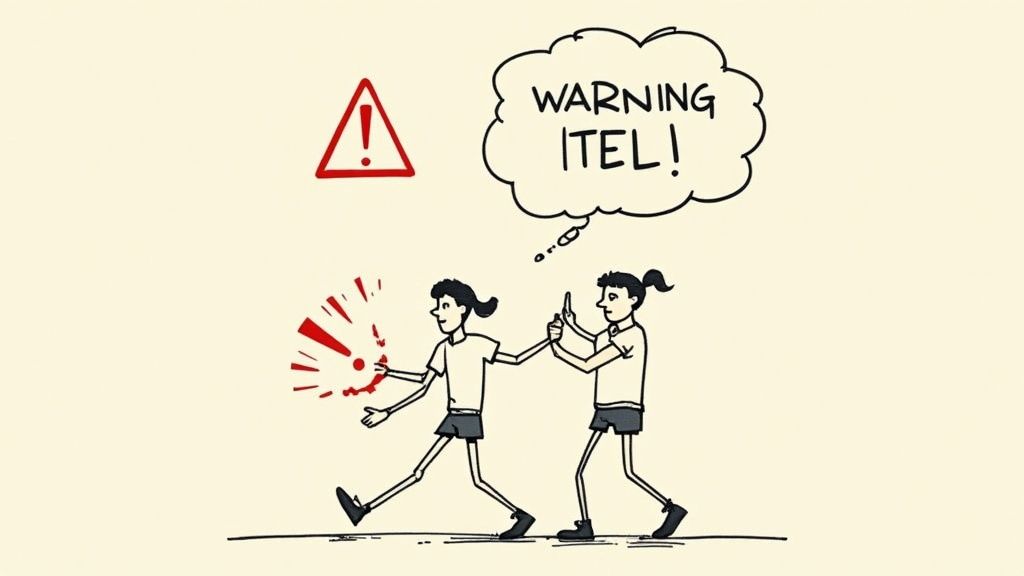
You can absolutely nail an interview and still lose the job with a clumsy follow-up. It happens more than you'd think. You've done all the hard work to present yourself as the perfect candidate, and the last thing you want is a poorly timed or badly written message to undo it all.
Think of your follow-up as the final lap. Avoiding a few common pitfalls is just as crucial as remembering to send one in the first place. A simple typo, an overly casual tone, or a generic script can signal a lack of attention to detail—a major red flag for any hiring manager.
Sending a Generic, Impersonal Message
The fastest way to get your thank-you email deleted is to send something that looks like you copy-pasted it. It just screams low effort and, frankly, a lack of real interest in this specific role.
- The Mistake: Using a vague template like, "Thank you for the interview for the position." It's forgettable.
- Why It Fails: It shows you weren't really listening. The whole point is to reignite the connection you built during the conversation, not just to check a box.
- The Fix: Always, always reference something specific you talked about. Mention a project that got you excited, a question they asked that made you think, or a shared interest you discovered.
This kind of personalization proves you see this opportunity as more than just one of a hundred applications you fired off this week.
Being Too Aggressive or Too Passive
There's a fine line between confident persistence and just being annoying. Bombarding the recruiter with multiple emails within a few days or demanding an immediate update makes you seem desperate, not determined.
On the flip side, not following up at all can easily be mistaken for a lack of interest. In a competitive market, silence is not golden. Poor communication is a massive turn-off for employers. In fact, 66% of job seekers said a positive candidate experience was a key reason they accepted an offer, and that experience hinges on clear, timely communication.
The key is balance. Your tone should be one of professional enthusiasm, not impatient demand. A polite, brief check-in about a week after the initial thank-you is perfectly fine if the timeline they gave you has passed.
Making It All About You
Your follow-up is not the place to rehash your entire resume. The focus should stay squarely on the company's needs and how you are the solution to their problems.
Don't just list your qualifications again. Instead, connect your skills directly back to the challenges or goals the interviewer shared with you. This subtle shift in framing moves the message from "Here's why I'm great" to "Here's how I can help you succeed." It’s a small change that makes a huge difference.
Even if you don't get the offer, keeping this professional, value-driven mindset is critical. You can learn more about navigating that outcome with grace in our guide on how to handle job rejection.
Answering Your Top Interview Follow-Up Questions
Walking that line between keen and... well, a little too much... can feel tricky after an interview. You want to stay top of mind, but you definitely don't want to become a pest. Let's tackle some of the biggest questions that pop up when you're staring at that blank "new message" screen.
Who Actually Gets the Follow-Up Email?
This one trips a lot of people up, especially when you've just done a whirlwind tour of the office meeting half the team. The simple, non-negotiable rule is this: send a personalized note to every single person you interviewed with.
I know, it sounds like a lot of work, but this is a serious power play. The hiring manager has one lens, your potential future teammate has another, and the HR coordinator sees things from a completely different angle. By sending each one a tailored message, you show you're not just thorough but also have a high degree of emotional intelligence.
If you were only given a single point of contact, that’s okay too. Just send your main thank-you note to them and add a quick, polite line asking if they could pass your gratitude along to the rest of the team.
Okay, But What About Group or Panel Interviews?
Group interviews are their own special kind of chaos. You’ve got multiple people, overlapping conversations, and it can be a real challenge to keep track of it all. The strategy here is basically the same, just with a little more prep.
- Get Everyone's Contact Info: This is priority one. Try to grab business cards as people leave, or at the very least, jot down each person's full name and title so you can find them later.
- One Person, One Email: Fight the urge to send a single mass email. Send a separate, unique message to each interviewer. This is your chance to shine.
- Recall a Specific Detail: Try to remember one unique thing each person said or asked. Maybe you connected with one person over their question about data analysis, and another about their thoughts on team culture. Mentioning it proves you were truly listening, not just waiting for your turn to talk.
It’s this attention to detail that separates the good candidates from the great ones. A generic blast to a group feels lazy; a series of thoughtful, individual notes feels impressive.
An interviewer once told me the candidate who ultimately got the job was the only one who sent individual thank-you notes after a panel interview. It wasn't the only reason they were hired, but it absolutely tipped the scales by showcasing exceptional soft skills.
I Completely Botched an Interview Question. Now What?
We've all been there. The perfect, eloquent answer crystallizes in your mind the second the elevator doors close. It's frustrating, but don't panic. Your follow-up email is the perfect opportunity for a quick, confident do-over.
The key is to avoid a long, rambling apology. That just draws more attention to it. Instead, frame it as a moment of further reflection.
For instance, you could say something like: "After thinking more about our conversation, I realized I could have given a stronger example for my experience with project management software. To add to what I said, I actually spearheaded the migration to Asana for my entire department, a project that boosted our team's efficiency by 20%."
See what that does? It flips a potential negative into a massive positive. You come across as thoughtful, self-aware, and you get one last chance to drive home a key qualification.
Ready to stop stressing and start impressing? AIApply crafts perfectly timed and personalized follow-up messages for you, ensuring you always make the right impression without the guesswork. Ditch the anxiety and let our AI handle the details so you can focus on acing your next interview. See how it works at https://aiapply.co.
Think the interview is over once you’ve logged off the video call or walked out the door? Not even close. Sending a follow-up message isn't just about being polite—it's one of the most underrated, strategic moves you can make in your job search.
This isn't just a thank-you note. It's your last chance to make a great impression, stand out from a sea of other candidates, and keep the conversation going.
Why Your Follow-Up Still Matters in Modern Hiring

In a world full of automated application systems and back-to-back virtual meetings, a genuine human touch goes a long way. Your follow-up message is exactly that—a rare chance to show your personality and professionalism outside the formal interview structure.
This is more than just good manners. It’s a smart, calculated move. A great follow-up proves you’re engaged, detail-oriented, and truly excited about the role. While other candidates might just blend into the background, a thoughtful message makes you memorable.
The Strategic Advantage of a Thoughtful Message
A well-crafted follow-up can do some serious heavy lifting for you and can genuinely sway a hiring manager's decision. It's your opportunity to:
- Show you’re still all in. Reiterate your enthusiasm for the job. It tells the interviewer your excitement wasn’t just an act for the camera.
- Connect the dots for them. Subtly remind them of a key skill you have that directly solves a problem they mentioned. You’re reinforcing why you’re the perfect fit.
- Prove your professionalism. Prompt, polite communication is a non-negotiable soft skill. Your follow-up is a real-time demonstration of that.
This is how you separate yourself from a pack of otherwise equally qualified people. You’re turning a simple courtesy into a powerful statement about your personal brand.
Let’s be real: hiring managers are swamped. A fantastic follow-up doesn't just remind them who you are—it makes their job easier by neatly summarizing your value and passion in one place.
Adapting to the Digital Hiring Process
With hiring moving increasingly online, the follow-up has become more critical than ever. We've all been in those slightly awkward virtual interviews where it's tough to build a real connection. In fact, 81% of recruiters expect virtual interviews to stick around long-term.
A personalized message helps cut through that digital distance. It conveys a genuine interest that sometimes gets lost over a video call. You can learn more about navigating these changes by exploring modern job search techniques.
Taking a few minutes to send a message shows you get the nuances of professional communication—a vital skill for any job today. You’re not just "checking a box." You're making one final, compelling argument for why you’re the right person for the team.
Mastering the Follow-Up Timeline
When it comes to the job search, timing can make or break your chances. Send that follow-up message too quickly, and you might come across as desperate. But wait too long, and your fantastic interview could become a distant memory in a hiring manager's busy week. Hitting that sweet spot shows you're professional, respectful, and genuinely interested.
The "24-hour rule" is the gold standard here. Always, always aim to send your initial thank-you note within one business day of the interview. This simple act keeps the great conversation you had fresh in their minds and puts you at the top of the pile.
This visual guide lays out the perfect cadence for your follow-up strategy.

As you can see, the key is to space out your communication. You want to show persistence, not become a pest.
To help you visualize this, here’s a simple breakdown of the ideal timeline.
Interview Follow Up Message Timeline
This structure ensures each message has a clear purpose and arrives at just the right moment.
Your First Move: The 24-Hour Thank You
This first email is non-negotiable. Seriously. It's your immediate chance to say thanks for their time, remind them of your excitement for the role, and smartly connect one of your skills to a specific point you discussed. A prompt message confirms your interest and establishes a professional, thoughtful tone from the get-go.
Think of it as a firm, digital handshake. It’s a small gesture, but it’s one that over 90% of interviewers actually appreciate. It’s a tiny action that leaves a huge positive impression.
What to Do When You Hear Crickets
Okay, so you sent the perfect thank-you, and now you're just waiting. If the hiring manager gave you a timeline—for example, "We'll be making a decision by the end of next week"—you absolutely have to respect it. Don't even think about pinging them before that date has passed.
If they didn't give you a specific date, a good rule of thumb is to wait about one full business week before sending a polite check-in. This shows you're still engaged and eager but also patient and respectful of their process.
A polite check-in isn't about asking, "So, did I get the job?" It's a professional nudge to ask about the status of the hiring process and gently remind them of your continued interest.
For instance, your note could be as simple as: "I hope you're having a great week. I'm just checking in on the timeline for the [Job Title] position and wanted to reiterate my strong interest. I'm really excited about the possibility of joining your team."
This approach keeps the dialogue open without putting anyone on the spot. This kind of thoughtful communication is just as crucial as the message you send right after applying. If you need some ideas, you can find great tips for crafting a compelling follow-up email for a resume that you can easily adapt for this situation.
Tweaking Your Timing for Different Interview Types
The exact timing might need a little adjustment depending on the interview format. You want your follow-up to match the tone and stage of the hiring process.
- Phone Screen: A quick, to-the-point thank-you within 24 hours is all you need. The follow-up cadence can be a bit more relaxed here.
- Multi-Person Panel: This requires more effort. Send a personalized thank-you note to each interviewer within 24 hours. After a week, a single follow-up to your main point of contact is enough.
- Final Round Interview: The stakes are high. Your 24-hour thank-you should be detailed and exceptionally thoughtful. The check-in you send a week later needs to be polished and professional, reinforcing your value one last time.
Once you get this timeline down, your follow-up messages become a powerful part of your strategy, ensuring your communication always comes across as proactive, not pushy.
The Anatomy of a Memorable Follow-Up Email

It’s time to ditch the generic, copy-paste templates. Let's build a follow-up email that a hiring manager will actually read, remember, and maybe even forward to the team.
Think of your email not as a single block of text, but as a series of strategic moves. Each part has a specific job. When you put them all together, you get a powerful message that reinforces why you're the right person for the job.
The goal here isn't just to say "thank you." It's to prove you were listening, to show off your professionalism, and to gently remind them that you are the solution to their problems. Every single line counts.
Crafting a Subject Line That Actually Gets Opened
Your subject line is the gatekeeper to the inbox. If it’s vague, weird, or unprofessional, your carefully written message might get buried or deleted without a second thought.
Keep it simple, clear, and professional. The hiring manager should know exactly who you are and what the email is about in a single glance. A winning formula usually mixes a brief "thank you" with the job title you interviewed for.
Here are a few no-nonsense examples:
Thank you - Marketing Manager InterviewFollowing up on the Project Coordinator roleJohn Smith - Follow up regarding Senior Analyst position
This approach is direct and instantly recognizable. It helps the hiring manager categorize your message in their sea of emails.
The Opening: Your Personalized Greeting
Always start strong by addressing the interviewer by their name. A generic "To Whom It May Concern" is a dead giveaway that you're just going through the motions. Use whatever name they introduced themselves with—if they said, "call me Jen," use Jen.
Right after that, express your thanks for their time. It's more than a formality; it shows you respect their packed schedule. Keep it genuine and to the point.
Pro Tip: If you met with several people, send each one a separate, slightly tweaked email. Mentioning a specific point that only you and that person talked about is an expert-level move. It proves you were actively engaged with everyone, not just the head honcho.
The Body: Connecting Your Value to Their Problems
This is where you make your money. The body of your email has two critical jobs: reiterate your excitement for the role and connect your skills to a specific challenge they're facing. This is your chance to add a little more value to the conversation you started.
Think back to the interview. What was the biggest headache or project they mentioned? Maybe they’re losing users, trying to break into a new market, or just need to fix a clunky internal process. Grab onto that pain point.
For instance, you could write something like: "I really enjoyed our conversation about streamlining the customer onboarding process. In my last role at XYZ Corp, I actually led a project that cut new-user churn by 15% in the first quarter by implementing a similar strategy."
See what that does? It transforms your thank-you note into a mini-case study. You're not just telling them you have the skills; you're proving it with a real, relevant number. If you need more ideas on hitting the right professional-yet-personable tone, checking out some other professional email examples can be a huge help.
The Closing: A Confident Call to Action
You want to end your message on a strong, forward-looking note. Reaffirm your interest one last time and say you’re looking forward to hearing about the next steps. This isn't the time to be pushy, but you absolutely want to sound confident and eager.
A simple, professional sign-off like "Best regards" or "Sincerely" works perfectly. Follow it with your full name and a clean signature with your contact info. This final touch leaves the hiring manager with a lasting impression of you as a polished, proactive candidate who has their act together.
Advanced Strategies to Outshine the Competition
https://www.youtube.com/embed/CqCOYTNQmBY
A standard thank-you note is table stakes. It’s polite, expected, and it checks a box. But if you want to move from being just another qualified candidate to the one they have to hire, you need to do more.
This is your chance to make one last, powerful impression. It's about demonstrating that you’re not just looking for a job—you’re already thinking about how to solve their problems and contribute to their team. Every message is an opportunity to add new value and make the hiring manager think, "Wow, this person is already bringing ideas to the table."
Tailor Your Message for Each Person
If you met with three different people, sending them all the same cookie-cutter email is a massive misstep. Think about it: the HR coordinator, the department head, and your potential future coworker all have completely different concerns and perspectives on who they should hire. Your follow-up needs to reflect that you understand this.
- The HR Coordinator: Your message here can be more process-focused. Thank them for their time and for coordinating everything. Reiterate your enthusiasm for the company and the role, keeping it professional and concise.
- The Hiring Manager: This is your most important follow-up. Go deep. Connect your experience directly to the specific challenges or goals they brought up in your conversation. Show them you not only heard them but that you're the solution to their problems.
- A Future Teammate: Keep this one more conversational and collaborative. You could mention a specific project they talked about that you found exciting or how much you enjoyed hearing about the team's dynamic.
This isn't just about being a good listener; it’s about showing you have the social awareness to navigate different relationships within a team. It’s a subtle but powerful skill.
The Value-Add Follow Up
This is the move that can really separate you from the pack. Instead of just saying thanks, you share something genuinely useful that’s related to your conversation. This proves you’re still thinking about their business long after you’ve left the building.
Let's say you talked about their plans to improve their content strategy. You could send a quick note with a link to a relevant article you found.
"Hi Sarah, I really enjoyed our discussion about your Q4 content strategy. It got me thinking, and I stumbled upon this fascinating report about emerging video trends in your industry that I thought you might find useful. Looking forward to hearing about the next steps."
This simple gesture reframes you from a job applicant to a proactive, resourceful partner. You're showing genuine engagement, not just going through the motions. To do this well, you obviously need to have done your homework. For more on this, check out our guide on how to research a company before an interview.
Gracefully Address an Interview Flub
We've all been there. The minute you walk out of an interview, the perfect answer to that one question you fumbled pops into your head. Don't sweat it. Your follow-up email is the perfect opportunity for a quick do-over.
No need for a lengthy apology. Just a brief, confident clarification will do the trick.
For example: "After reflecting on our conversation about project management tools, I realized I didn't fully explain my experience with Asana. I actually led the platform's rollout for a 30-person team, which resulted in a 20% increase in on-time project completion."
This tactic is brilliant because it turns a potential negative into a positive. It shows you're self-aware, thoughtful, and have a high attention to detail.
Don't underestimate how much these extra touches matter. According to a 2025 survey, 86% of hiring managers report that a thank-you note influences their decision-making process. You can find more insights like this in Apollotechnical.com's compilation of job interview statistics. A little extra thought can truly make all the difference.
Common Follow-Up Mistakes That Can Cost You The Job

You can absolutely nail an interview and still lose the job with a clumsy follow-up. It happens more than you'd think. You've done all the hard work to present yourself as the perfect candidate, and the last thing you want is a poorly timed or badly written message to undo it all.
Think of your follow-up as the final lap. Avoiding a few common pitfalls is just as crucial as remembering to send one in the first place. A simple typo, an overly casual tone, or a generic script can signal a lack of attention to detail—a major red flag for any hiring manager.
Sending a Generic, Impersonal Message
The fastest way to get your thank-you email deleted is to send something that looks like you copy-pasted it. It just screams low effort and, frankly, a lack of real interest in this specific role.
- The Mistake: Using a vague template like, "Thank you for the interview for the position." It's forgettable.
- Why It Fails: It shows you weren't really listening. The whole point is to reignite the connection you built during the conversation, not just to check a box.
- The Fix: Always, always reference something specific you talked about. Mention a project that got you excited, a question they asked that made you think, or a shared interest you discovered.
This kind of personalization proves you see this opportunity as more than just one of a hundred applications you fired off this week.
Being Too Aggressive or Too Passive
There's a fine line between confident persistence and just being annoying. Bombarding the recruiter with multiple emails within a few days or demanding an immediate update makes you seem desperate, not determined.
On the flip side, not following up at all can easily be mistaken for a lack of interest. In a competitive market, silence is not golden. Poor communication is a massive turn-off for employers. In fact, 66% of job seekers said a positive candidate experience was a key reason they accepted an offer, and that experience hinges on clear, timely communication.
The key is balance. Your tone should be one of professional enthusiasm, not impatient demand. A polite, brief check-in about a week after the initial thank-you is perfectly fine if the timeline they gave you has passed.
Making It All About You
Your follow-up is not the place to rehash your entire resume. The focus should stay squarely on the company's needs and how you are the solution to their problems.
Don't just list your qualifications again. Instead, connect your skills directly back to the challenges or goals the interviewer shared with you. This subtle shift in framing moves the message from "Here's why I'm great" to "Here's how I can help you succeed." It’s a small change that makes a huge difference.
Even if you don't get the offer, keeping this professional, value-driven mindset is critical. You can learn more about navigating that outcome with grace in our guide on how to handle job rejection.
Answering Your Top Interview Follow-Up Questions
Walking that line between keen and... well, a little too much... can feel tricky after an interview. You want to stay top of mind, but you definitely don't want to become a pest. Let's tackle some of the biggest questions that pop up when you're staring at that blank "new message" screen.
Who Actually Gets the Follow-Up Email?
This one trips a lot of people up, especially when you've just done a whirlwind tour of the office meeting half the team. The simple, non-negotiable rule is this: send a personalized note to every single person you interviewed with.
I know, it sounds like a lot of work, but this is a serious power play. The hiring manager has one lens, your potential future teammate has another, and the HR coordinator sees things from a completely different angle. By sending each one a tailored message, you show you're not just thorough but also have a high degree of emotional intelligence.
If you were only given a single point of contact, that’s okay too. Just send your main thank-you note to them and add a quick, polite line asking if they could pass your gratitude along to the rest of the team.
Okay, But What About Group or Panel Interviews?
Group interviews are their own special kind of chaos. You’ve got multiple people, overlapping conversations, and it can be a real challenge to keep track of it all. The strategy here is basically the same, just with a little more prep.
- Get Everyone's Contact Info: This is priority one. Try to grab business cards as people leave, or at the very least, jot down each person's full name and title so you can find them later.
- One Person, One Email: Fight the urge to send a single mass email. Send a separate, unique message to each interviewer. This is your chance to shine.
- Recall a Specific Detail: Try to remember one unique thing each person said or asked. Maybe you connected with one person over their question about data analysis, and another about their thoughts on team culture. Mentioning it proves you were truly listening, not just waiting for your turn to talk.
It’s this attention to detail that separates the good candidates from the great ones. A generic blast to a group feels lazy; a series of thoughtful, individual notes feels impressive.
An interviewer once told me the candidate who ultimately got the job was the only one who sent individual thank-you notes after a panel interview. It wasn't the only reason they were hired, but it absolutely tipped the scales by showcasing exceptional soft skills.
I Completely Botched an Interview Question. Now What?
We've all been there. The perfect, eloquent answer crystallizes in your mind the second the elevator doors close. It's frustrating, but don't panic. Your follow-up email is the perfect opportunity for a quick, confident do-over.
The key is to avoid a long, rambling apology. That just draws more attention to it. Instead, frame it as a moment of further reflection.
For instance, you could say something like: "After thinking more about our conversation, I realized I could have given a stronger example for my experience with project management software. To add to what I said, I actually spearheaded the migration to Asana for my entire department, a project that boosted our team's efficiency by 20%."
See what that does? It flips a potential negative into a massive positive. You come across as thoughtful, self-aware, and you get one last chance to drive home a key qualification.
Ready to stop stressing and start impressing? AIApply crafts perfectly timed and personalized follow-up messages for you, ensuring you always make the right impression without the guesswork. Ditch the anxiety and let our AI handle the details so you can focus on acing your next interview. See how it works at https://aiapply.co.
Don't miss out on
your next opportunity.
Create and send applications in seconds, not hours.






